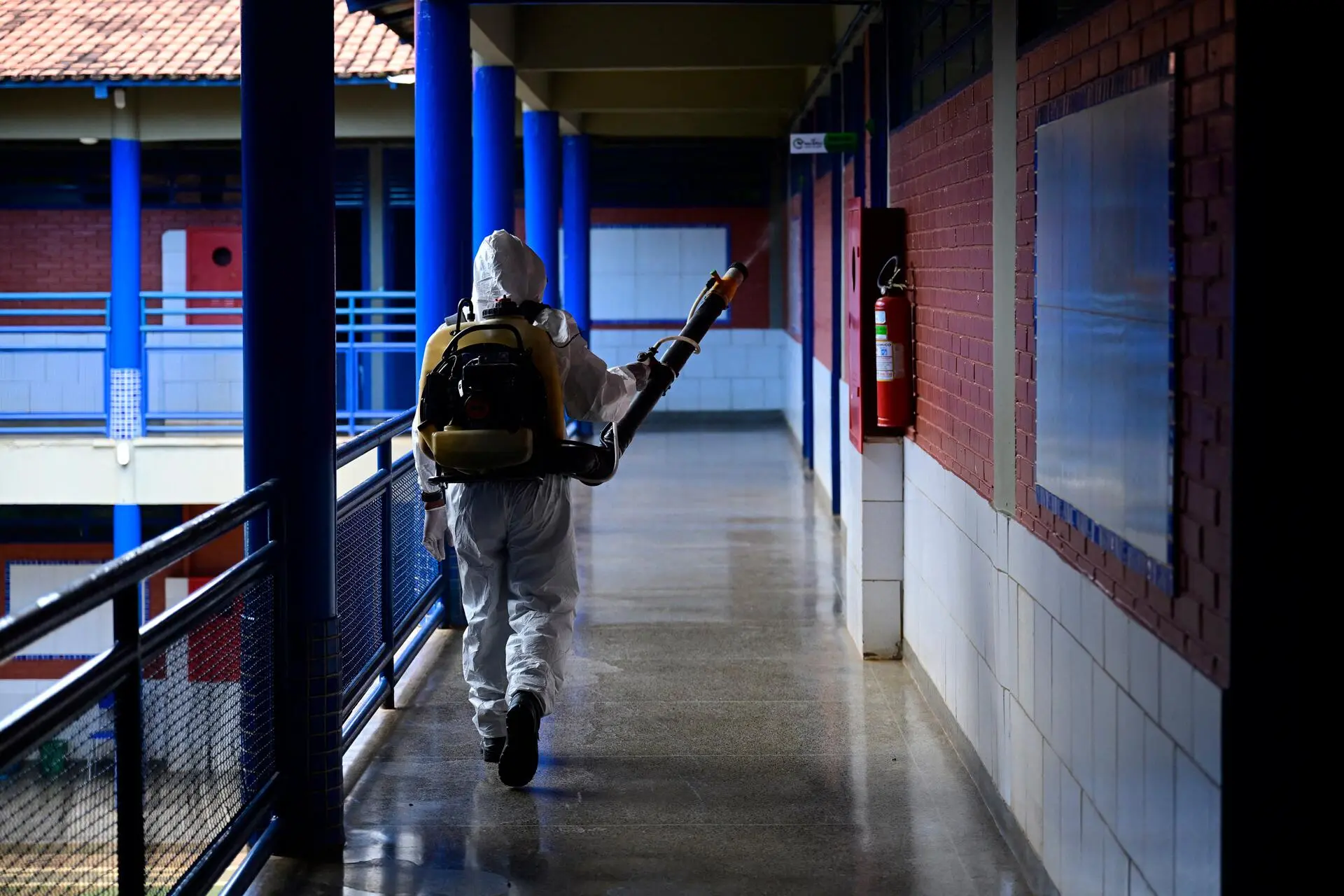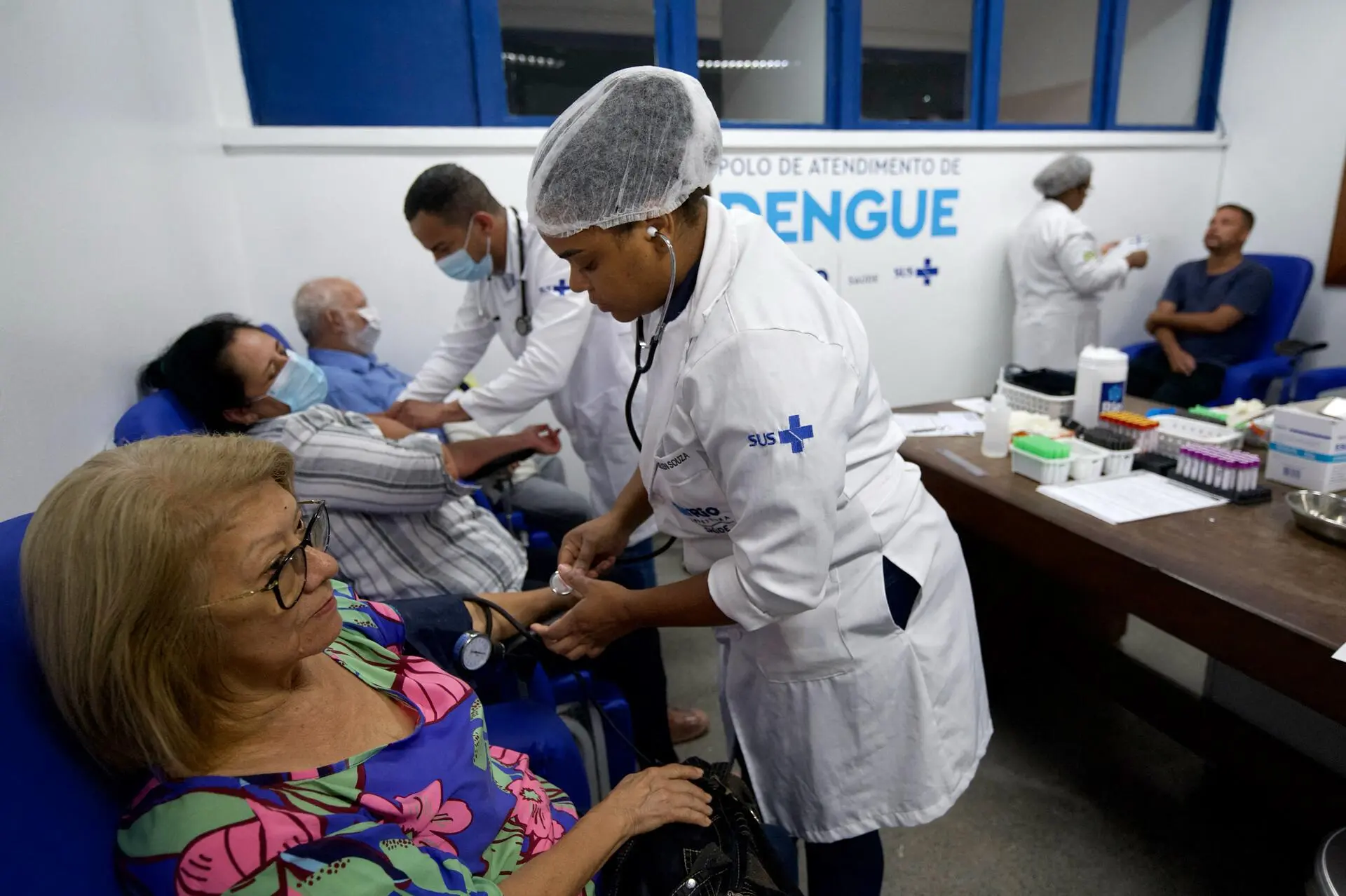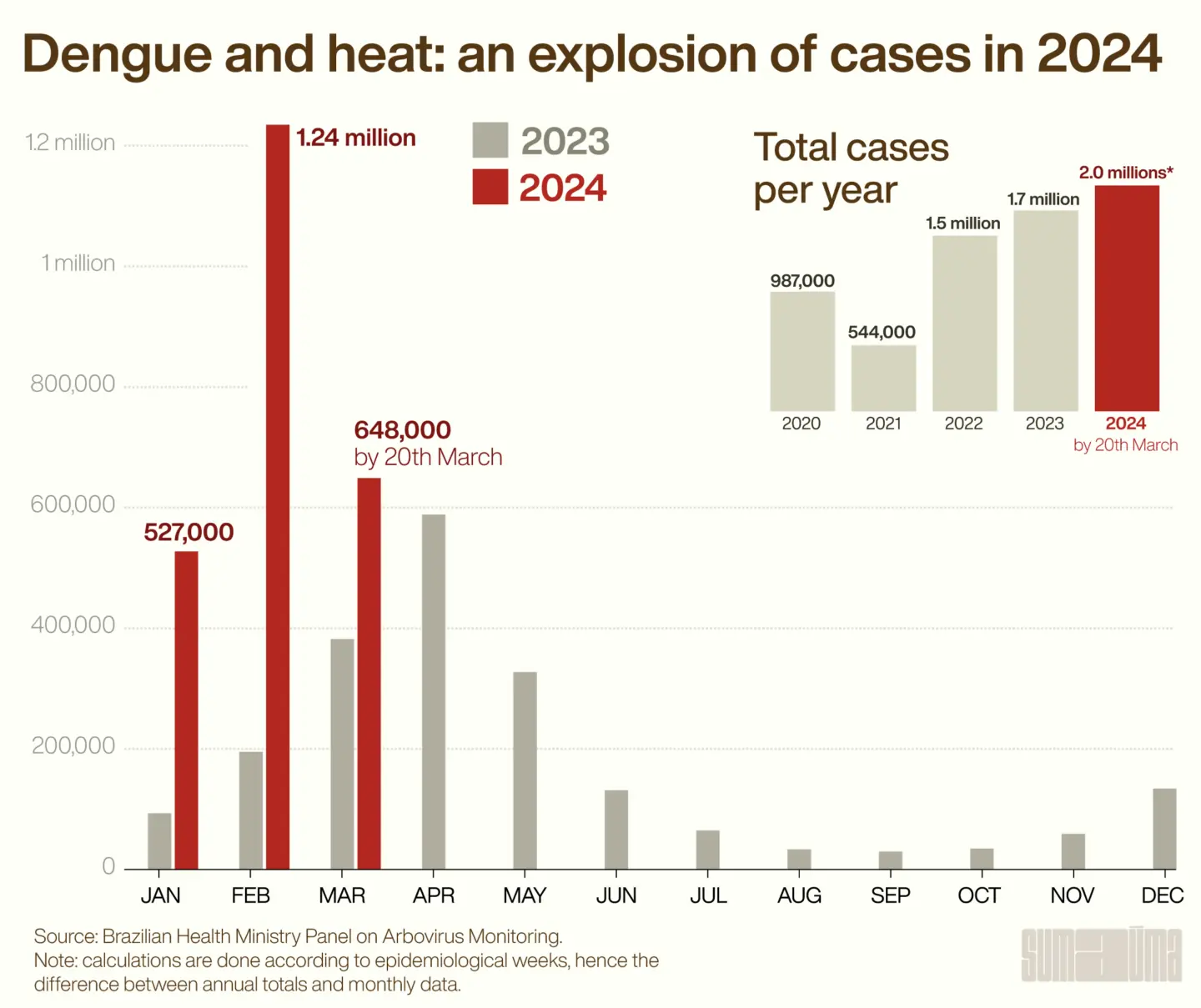Dengue cases in Brazil are off the charts – as is the temperature. It is no coincidence that the country is experiencing record heat along with more and more people falling ill after being bitten by the Aedes aegypti mosquito. After all, the climate is more comfortable for this tiny bug from Africa, which carries viruses causing not only dengue, but zika and chikungunya.
By March 20, Brazil already had 1.9 million suspected cases of dengue on record, with 656 deaths confirmed and another 1,025 under investigation. Even though the disease has yet to hit its peak, which usually occurs between April and May, the numbers for 2024 are already approaching the figures seen for the entirety of 2023, when the country broke its record for deaths from the virus (1,094 deaths) and had in excess of 1.6 million infections. Last year was also the hottest on record in Brazil going back to 1961, when the country’s National Institute of Meteorology began to track temperatures. And it looks like this year could also surpass this mark.
The recent epidemics of dengue and other mosquito-borne diseases are more stark evidence of the extent of climate change‘s effects on human populations. Beyond direct consequences, like deaths from waves of excessive heat, hunger from extreme droughts and forced relocations from floods, the impacts on the public’s health and wellness around the world are increasingly evident – and forecasts for the future are not encouraging.
Just as with any process in Nature, a variety of factors influence the behavior of a species and these factors determine if, where, and for how long this species will survive. Some of them are natural, others are less so. In the case of the Aedes aegypti, the planet is becoming a more agreeable place for this mosquito species because of a shift in weather patterns that has been occurring as a result of atmospheric pollution caused by man, what scientists call “anthropogenic emissions.” The climate crisis has not only resulted in higher temperatures, but also in changes to wet and dry weather patterns.
With its translucent wings and dark body covered in white stripes that also circle their heads and legs, Aedes aegypti depend on relatively high temperatures and high humidity to successfully multiply, since its eggs will only hatch under these conditions and the mosquito’s larvae need environments with standing water to develop. Studies have shown, for example, that exposure to temperatures of less than 10 degrees Celsius over long periods can be lethal to eggs, and the rate of larva survival is much higher when the weather is between 15 to 36 degrees Celsius (59 to 97 degrees Fahrenheit).
“At these temperatures eggs hatch more easily and mortality ends up being lower, because they hibernate for less time. Put another way, more mosquitoes survive in these conditions. They develop and begin to circulate, increasing the chance that they will bite an infected person, becoming a vector for the disease and spreading the virus,” explains Christovam Barcellos, one of Brazil’s foremost experts in health surveillance and the coordinator of the Climate and Health Observatory at the Oswaldo Cruz Foundation.

Outbreak: spraying insecticides, like in this school in Brasília, is one of the actions taken to mitigate the disease’s uncontrolled growth. Photo: Mateus Bonomi/Agif
The females of the species are responsible for the dreaded bites, as they need nutrients from human blood to develop their eggs. The male feeds exclusively on sugary substances, like nectar and fruit. It’s worth remembering that unlike other species of mosquitoes, who only feed from one person for each batch of eggs they lay, Aedes aegypti females are capable of biting more than one individual for the same batch of eggs, further increasing the potential to spread the disease. An adult mosquito can live for up to around 40 days. And females distribute their eggs around a variety of nurseries, a strategy that guarantees the spread and preservation of the species.
The heat helps to not only boost mosquito survival rates, but also in speeding the development of their lifecycle. Researchers from the State University of Campinas (Unicamp) are cited in a chapter on dengue and climate change in the book Climate Change and Global Public Health, one of the most comprehensive publications presenting scientific evidence on the relationship between the climate and public health. The Unicamp scientists noted the time a larva takes to become an adult mosquito could fall from 15 days to one week or less once the temperature goes from 20 to 30 degrees Celsius (68 to 86 degrees Fahrenheit).
Eggs take around two days to hatch when the temperature is at 31 degrees Celsius (88 degrees Fahrenheit) and up to 20 days to hatch when it is at 16 degrees Celsius (60 degrees Fahrenheit). The behavior of these adult mosquitoes is also affected by the climate. With temperatures close to 30 degrees Celsius (86 degrees Fahrenheit), females develop faster and become smaller adults (they grow less), which results in them being less able to store the energy they get from blood. That is why they need to bite more humans in a row, to “fill the tank.”
The effects of climate change go even further. The increased frequency and intensity of extreme events has made it easier for the mosquito to proliferate, as shown by a study published in 2021 by Lancet Planet Health, one of the world’s most influential scientific journals. The study, developed by institutions in the United Kingdom, Brazil, the United States, Peru and Saudi Arabia, looked at the impact of intense rains and prolonged droughts on dengue’s presence in Brazil over the first two decades of the twenty-first century, finding that both phenomena helped to make outbreaks of the disease worse.
Regarding rainfall, the explanation is more simple: the species needs moist locations to lay its eggs, and the more rain, the more water accumulates. In analyzing prolonged droughts, the story is a bit more complex. “In these situations, especially in urban zones, people tend to store water inside of their homes and in a precarious manner, which facilitates the mosquito’s development. In southern Brazil, for instance, we’ve had several years where the La Niña phenomenon has caused severe droughts, and in these same periods there were major outbreaks of the disease,” says Christovam Barcellos, of the Oswaldo Cruz Foundation.
Researcher Sergio Pacca, a coordinator of the environmental management program at the University of São Paulo, says the trend of rising global temperatures seen in recent decades brings with it irregular rainfall and drought regimens, which create a very hospitable environment for the mosquito, considering both time and space. “The mosquito is able to arrive and establish itself in regions that up until recently had not reached high enough temperatures for their propagation. They also remain active for longer in certain regions because of the persistence of heatwaves, even into winter,” Pacca says.
One impact of this is the changed weather pattern being seen this year in the country. Historically, Brazil has usually had a higher number of dengue cases in the months of April and May. Yet while the month of March 2024 has yet to end, rates of infection are already sky-high. “We’ve never had a March with so many cases, and this is happening because the dengue got a head start. The curve, which normally starts in January, began to rise in September of last year, when it was still winter, but it was a warm winter,” Barcellos explains.

Aid: people are quickly contaminated because the female mosquitos, which transmit the virus, need to bite more to store energy. Photo: Mauro Pimentel/AFP
He also calls attention to a rise in cases in regions that had up to that point seen low rates of transmission. In one of the more recent studies on the topic, published in March in Scientific Reports, a journal published by the Nature Research group, Barcellos and a team of scientists from the Oswaldo Cruz Foundation found the regions that are growing hotter – around 2 to 3 degrees Celsius (3 to 5 degrees Fahrenheit) above average – and are suffering from environmental degradation have the most significant outbreaks of the disease. So far, according to the most recent data from the Health Ministry, Minas Gerais is the state with the highest number of probable dengue cases, followed by São Paulo, Paraná, and the Federal District. All have already declared a state of emergency. The study also shows that climate change, deforestation, and the advancement of roads into the Amazon are turning the country’s North region into a permanent virus transmission zone.
Barcellos says dengue is also climbing in altitude. “If up until recently the highest rates of infection were in lower cities [like those in coastal regions], they are now also appearing in regions with altitudes of 500 to 1,000 meters [1650 to 3250 feet], which are suffering from the higher annual temperature.”
Growth in dengue case numbers is not just happening in Brazil. A few months ago, the Pan American Health Organization issued an epidemiological alert on the disease’s growth in the Americas. The scenario is made worse by the El Niño phenomenon (associated with the abnormal warming of the Pacific Ocean’s waters), especially for countries like Peru, Mexico, and Argentina. If by the 1970s only nine countries had serious dengue epidemics on record, the World Health Organization (WHO) is now warning the disease has become endemic, that is, it occurs in a concentrated manner in a specific region, in more than 100 countries in Africa, the Americas, the Middle East, Southeast Asia, and the Western Pacific. Various locales in Europe have seen growth in rates of locally-acquired cases. For example, in 2023, Italy, France, and Spain had over 100 infections. This exceeds the 71 cases notified in 2022. In 2021, there were just two cases on record, according to the European Centre for Disease Prevention and Control.
More emissions = more dengue
If the current pace of greenhouse gas emissions is not drastically reduced, experts warn the situation should grow worse. The number of people at risk of contracting dengue could reach 60% of the world’s population in 2080, an increase of 2.25 billion people compared to 2015 – this was shown in a study led by researchers from Oxford University, in England, which was published in 2019 in Nature Microbiology, a journal of the Nature Research group.
In November 2023, the Lancet Countdown, another publication studying the relationship between climate change and public health, put out its eighth report, which estimated that the potential for transmitting dengue could rise by up to 37% worldwide by 2050. And the Global South, the group of countries that are the poorest and have the least ability to handle health emergencies, will be the most affected. Inequality is, it appears, one of the most alarming facets of the climate crisis: groups in vulnerable situations, such as those living in precarious conditions and without basic sanitation, are being affected the most by dengue outbreaks. In 2024, mixed race women were the population group with the most cases in Brazil, according to the Health Ministry.
Although worrisome, these warnings are nothing new. For at least three decades there has been a published, documented, and detailed scientific consensus on the dangerous relationship between the climate crisis and the increased circulation of diseases transmitted by vectors. In 1995, in the second report from the Intergovernmental Panel on Climate Change, scientists from around the world had already stated that “indirect effects of climate change (…) include increases in the potential transmission of vector-borne infectious diseases (e.g., malaria, dengue, yellow fever and some viral encephalitis).”
However, from then to now greenhouse gas emissions have continued to grow exponentially and the planet is warming at record speed. Just in Brazil – which ranked sixth in the shameful list of the biggest contributors to the release of carbon gas (CO₂) into the atmosphere – emissions rose from 1990 to 2022 by 13%. The main cause of gas emissions in Brazil is the so-called change in land use, which includes practices like fires and deforestation, especially in the Amazon.
Far beyond the unmistakable influence of the climate on a spike in dengue case numbers around the world, these scientific studies have been showing how hard it is for man to understand Nature’s complexity, the relationships and connections between species and, even more seriously, how the current model of society is threatening the very survival of humankind.
“Even if science shows the correlation between higher temperatures and increased disease, the right thing is not to establish this direct relationship, because then it seems like a fatality, it seems like nothing can be done,” says health surveillance expert Christovam Barcellos. Indeed, investing in public policies, effective strategies to lower greenhouse gas emissions, and adequate sanitation and housing conditions are just a few examples of measures that could – and still can – be effective in suppressing the disease’s spread. Yet as the researcher says, the most tragic aspect of the situation is that all of this could have been done but wasn’t – in his words, we are not functioning as a society. “If we don’t realize this, we will be attributing to the climate something that is the responsibility of citizens and governments.”
Editing: Malu Delgado e Talita Bedinelli
Photo Editor: Lela Beltrão
Fact-checker: Plínio Lopes
Proofreader (Portuguese): Valquíria Della Pozza
Spanish translation: Meritxell Almarza
English translation: Sarah J. Johnson
Infographics: Rodolfo Almeida
Copyediting and finishing: Érica Saboya
Editorial workflow: Viviane Zandonadi
Editor-in-chief: Talita Bedinelli
Editorial director: Eliane Brum

Prevention: spraying is one of the measures public agencies are taking to kill mosquitoes and contain the spread of the virus. Photo: Adriana Toffetti/Ato Press/Folhapress






